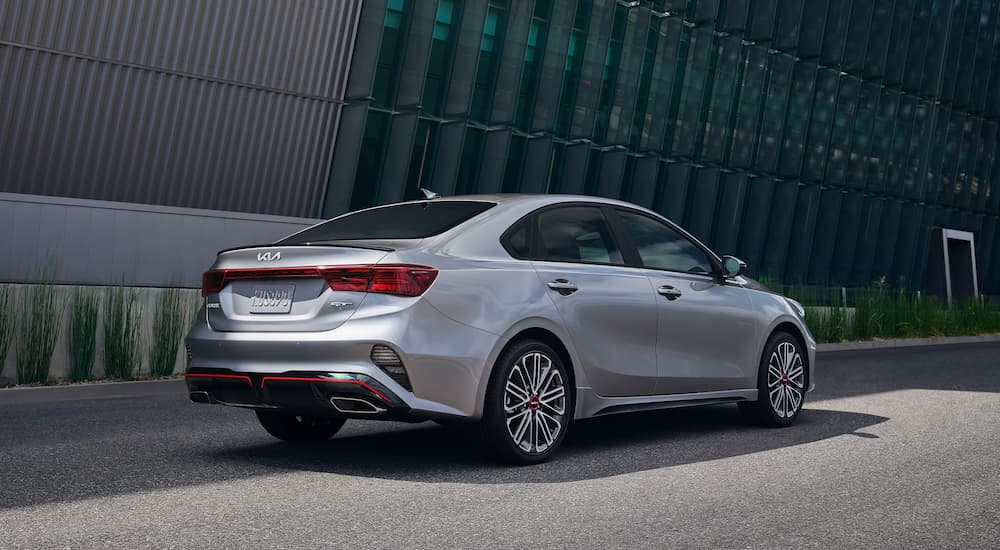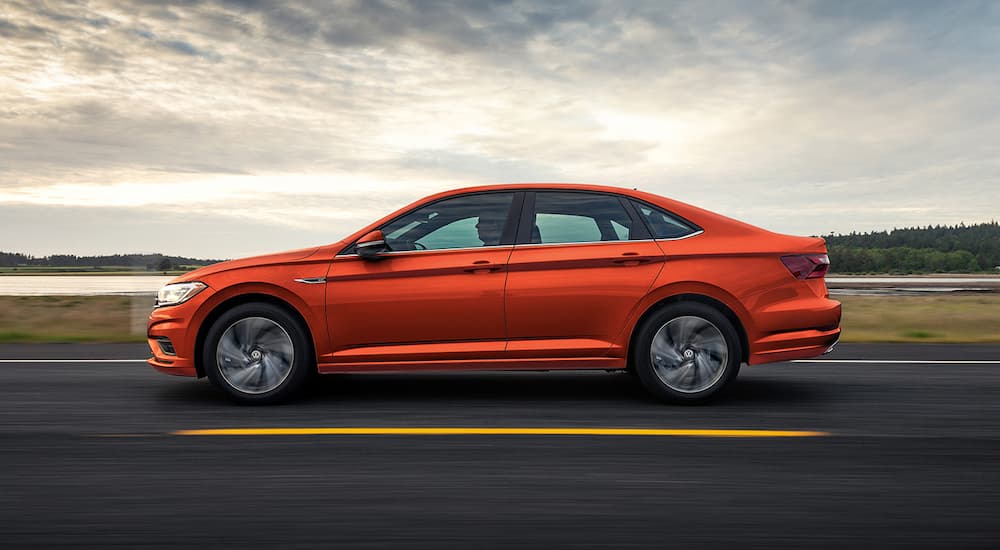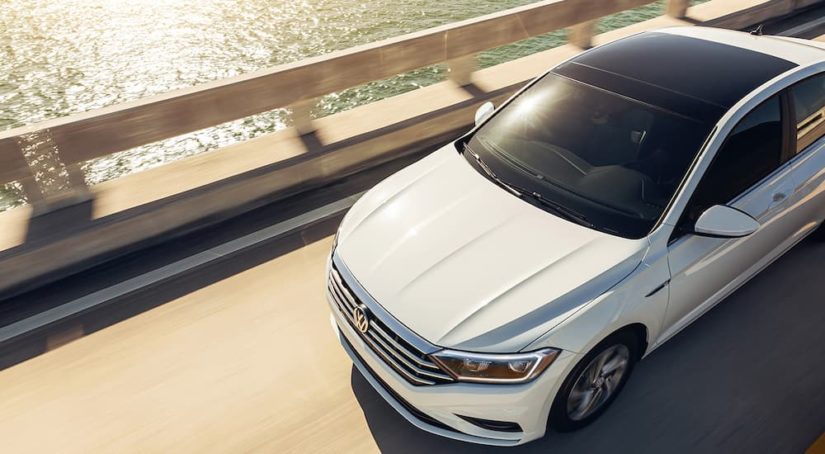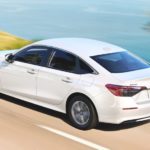It’s no secret that between inflation and the rising price of gasoline, commuting to work is more of a chore than it has ever been. With the national average cost of a gallon of fuel sitting around $5 a gallon, ensuring that your next commuter car is fuel-efficient is one of the most important factors in buying a new car. While domestic manufacturers focus on EV and SUV development, foreign car makers have not forsaken the natural fuel efficiency of small sedans. Sedans and hatchbacks are still very popular outside of North America, as gasoline prices are far higher abroad than they are here at home (as difficult as that is to believe). Today we’ll be cross-examining two entry-level sedans: the 2022 Volkswagen Jetta vs 2022 Kia Forte.
VW has a long history of excellence in engineering, continually producing best-selling vehicles that reach a global market. Some of VW’s greatest hits include the ever-recognizable Beetle, the hippie legend Type 2 Van, and the hot hatch Golf GTI. By contrast, Kia has had to continually fight for its place among the automotive giants. Since its arrival in America in 1993, this South Korean automaker has traditionally been a more affordable, albeit spartan, option. However, over the years, Kia has upped its game dramatically. With the Kia Stinger holding J.D. Power’s 2019 Engineering Award for Highest Rated All-New Vehicle and the recipient of Business Insider’s 2018 Car of the Year Award, today’s Kia offers far more in the way of comfort, fuel efficiency, power, and style than its vehicles of the past.
Both the Jetta and the Forte are similar enough to warrant this side-by-side comparison but different enough to make for an engaging competition. As most commuters operate on a budget, we’ll be looking at the entry-level trims for each, examining what comforts are included, as well as price, and what the fuel economy numbers are. Let’s dive in.

Some Background
The Jetta has become a bit of an icon for VW. Not in the way that the Beetle, Golf, or Van have, but in an understated way that can almost go unnoticed. The Jetta is a conservative, small sedan built with a singular purpose in mind: to get you from point A to point B reliably and comfortably. The Jetta can be seen in virtually every commuter city, from the traffic-jammed, sometimes snow-covered highways in and around Boston, MA, to the sunny suburbs of Los Angeles, CA. It’s a car that’s reliable and has proved more than capable of holding its own against the SUV onslaught that is the modern automotive market.
The Forte stands on the same merits, though its history is not nearly as entrenched. When introduced to the American market in 2010, the Forte was an economical sedan with elementary styling. Now well into its third generation, the Forte has a sporty, aggressive, angular design, along with an updated interior and plentiful technology options. Much like the Jetta, the Forte is a small sedan meant almost exclusively for easy, efficient commuting. Though, in a market that is so filled with ever-increasing sports-tuned packages and luxurious trim levels, it’s hard to see where the Jetta and Forte could compete. Well, in the three areas we mentioned earlier: comfort, price tag, and fuel economy.
Comfort on the Jetta
We’ll start with comfort because everyone enjoys a comfortable ride and interior. As far as ride comfort, the base trim Jetta S comes in FWD and sits on standard 16″ alloy wheels. The suspension system in the S is mildly tuned to have a sporty feel, with more road feel under the tires and tight handling and handling on corners. On the highway, the ride is smooth and acceleration is easily achieved. Standard interior comfort features in the Jetta S include a 6-way manual adjustable driver’s seat with body-hugging contours and lumbar support, a multifunction steering wheel with audio and climate controls, air conditioning, and cloth trimmed, 60/40 folding rear seats.
On the technology front, since tech counts for creature comforts these days, you get close to VW’s full suite of onboard features, including Bluetooth, App-Connect for Apple CarPlay and Android Auto, a 6.5″ color touchscreen with AM/FM radio, cruise control, two USB-C ports, and the VW digital cockpit. The digital cockpit is standard on all modern VWs, showing a completely digital instrument cluster display while also providing state-of-the-art navigation on higher trims.
If safety is another concern of yours that adds to your overall comfort level, the Jetta comes standard with all the basics: an anti-lock braking system, electronic stability control, side-curtain airbags, and a rear camera. However, it also has some higher-end safety features standard, including blind-spot monitoring, automatic emergency braking, and VW’s intelligent crash response system.
Comfort on the Forte
Despite Kia long being thought of as an entry-level brand, one that offers low prices and therefore fewer features, the 2022 Forte stands out as a compelling competitor. The base Forte, called the FE, is jam-packed with some of Kia’s latest safety and entertainment technology. Like the Jetta, the Forte is FWD, but the base trim sits on decidedly unsporty 15″ steel wheels. Ride-wise, the suspension in the Forte is also not as sport-tuned as the Jetta, but the FE does come with three available drive modes via the Drive Mode Selector: Normal, Sport, and Comfort. These modes will adjust throttle response, sharpening it for sporty driving or dulling it for improved fuel efficiency.
Inside the Forte FE, you’ll find a 6-way, cloth-trimmed driver’s seat, a mostly analog instrument display, and a telescoping steering wheel with audio and cruise controls. For tech, the FE comes standard with an 8″ touchscreen display integrated with Bluetooth, Apple CarPlay, and Android Auto connectivity, as well as four speakers. And while it is pretty basic fare for modern vehicles, the Forte leaves the production line armed with Kia Drive Wise Driver Assist Technology. This includes forward collision warning, lane keep assist, lane following assist, driver attention warning, rear view monitoring with parking guidance, and rear occupant alert. Also standard are traction control, anti-lock brakes, hill start assist, and rear child safety locks.

Fuel Economy
Okay, we know you’re more than anxious to learn the fuel economy numbers, so we’ll get straight to it.
The standard engine on the Jetta is a 1.5L 4-cylinder turbo making 158 hp and mated to a 6-speed manual transmission, making this car one of the few mass-produced vehicles that still offers a manual transmission. This combination gives the 2022 Jetta a fuel economy of 29 MPG in the city and 43 MPG on the highway. However, there is also an option to upgrade to an 8-speed automatic, which adjusts the numbers to 31 MPG in the city and 41 MPG on the highway.
Over in the Forte, we have a 2.0L 4-cylinder making 147 hp and mated to a continuously variable transmission. The lower power and unresponsive transmission further contribute to the Forte’s mundane driving experience, and there is no payoff in terms of fuel economy. In fact, the 2022 Forte gets the same 31 MPG in the city and 41 MPG on the highway as the Jetta with its more powerful engine and optional 8-speed automatic!
Two Compelling Options
So, you’re left here with two pretty compelling options. On the one hand, the Jetta is a long-established sedan with a history of fuel efficiency and longevity while also providing some of VW’s latest technology and a 6-speed manual transmission as standard. If you’re questioning why VW is still clinging to a manual transmission, don’t underestimate the cool factor of being able to drive stick. On the other hand, you have the Forte, which has gone through many changes to get to where it is now: a sleek, efficient, honestly appealing sedan with great technology and comfort features. So, discerning commuters, should you soon be looking for two efficient sedans to choose from as your work chariot of choice, take a good solid look at these two.



